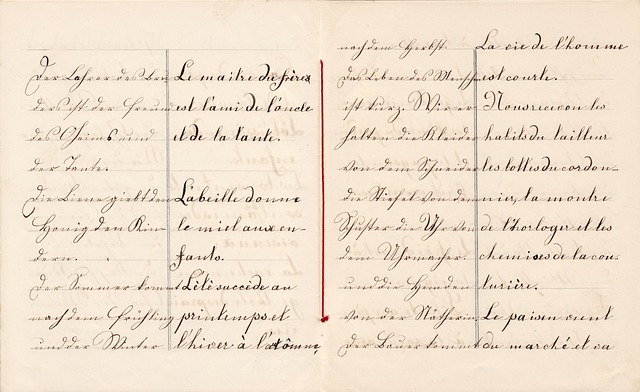Cultural nuances are key in translation, shaping tone and meaning across languages. Idioms, expressions, and social contexts vary widely, impacting phrase perception. Skilled translators must consider target audience expectations, including gender-neutral language. Bilingualism aids in finding culturally fitting linguistic matches. Effective communication relies on understanding language nuances, especially in marketing, literature, or content aiming to evoke sentiment among diverse global audiences. Translation Techniques offers solutions for precise and culturally sensitive messaging worldwide.
The art of translation involves more than just word-for-word substitutions; it’s a delicate dance between cultures, languages, and context. This article explores the multifaceted reasons behind tone shifts in text translation. From cultural nuances that shape sentiment to language features influencing expression, every aspect plays a role. We delve into the importance of adaptability when facing contextual changes and uncover potential biases that can create subtle yet significant differences in translated works, underscoring the complexity of this ancient practice, translation.
- Cultural Nuances Shape Tone in Translation
- Language Features Impact Sentiment Expression
- Contextual Changes Require Adaptability
- Translator's Bias and Subtle Differences
Cultural Nuances Shape Tone in Translation

Cultural nuances play a pivotal role in shaping the tone during translation processes. Every language carries with it unique cultural implications, idioms, and expressions that can significantly alter the intended meaning. When translating texts across languages, capturing the essence of these cultural subtleties is essential to convey the right tone. For instance, what may seem as a polite phrase in one culture could be perceived differently due to nuances in social context, leading to a change in translation tone.
Understanding the target audience’s cultural landscape and their expectations from language is crucial. Gender-neutral language, for instance, is an important consideration, especially when translating content aimed at a diverse audience. Bilingualism offers a unique perspective here, as translators can draw on their knowledge of both cultures to find the most fitting linguistic matching. By embracing these nuances, translators ensure that the translated text resonates with readers, maintaining the original intent and tone.
Language Features Impact Sentiment Expression

The nuances of language significantly influence how sentiment is conveyed in written communication. When translating texts for global markets, understanding these subtle differences is paramount to maintaining conceptual accuracy. Different languages have unique ways of expressing emotions and ideas, often with distinct grammatical structures and vocabulary that shape their tonal qualities. For instance, some languages may use more direct and explicit phrasing to convey enthusiasm or anger, while others employ more indirect and nuanced expressions.
Mastering translation skills involves not just substituting words but grasping these cultural and linguistic nuances. A skilled translator must be adept at interpreting the intended emotional impact of a text in its source language and finding equivalent ways to express it accurately in the target language. This is especially crucial when translating marketing materials, literature, or any content that relies heavily on sentiment to engage audiences. Giving us a call at Translation Techniques can help ensure your messages transcend linguistic barriers with precision and emotional resonance across diverse global markets.
Contextual Changes Require Adaptability

In translation, contextual changes require adaptability to accurately convey meaning and intent. Different languages have unique grammatical structures, idioms, and cultural references that directly impact tone. A simple phrase in one language might translate into a complex sentence structure in another, requiring skilled translators to adapt their approach. For instance, the subtleties of humor or sarcasm often lose their edge during translation, as what is considered amusing in one culture may not be understood in another. Efficient translating involves not just word-for-word substitutions but also understanding and respecting cultural nuances.
Moreover, film localization and localizing content for different audiences demand a fine-tuned approach to tone. When translating scripts or subtitles, translators must capture the essence of dialogue while adhering to regional preferences and norms. This delicate balance ensures that the translated material resonates with viewers, avoiding potential offensive terms that could offend specific cultural groups. Give us a call at your convenience to discuss how our professional translation services navigate these complex landscapes seamlessly, ensuring your content is both culturally sensitive and engaging for global audiences.
Translator's Bias and Subtle Differences

The tone of a translated text can often feel subtly different from the original, and this variation is largely attributed to the translator’s inherent biases and cultural background. Translators are not just neutral facilitators; their personal perspectives and experiences shape their choices during the translation process. This subjectivity can lead to nuanced differences in how certain concepts or emotions are conveyed. For instance, what seems like a subtle change from formal to informal language might reflect the translator’s own social context and cultural norms.
Moreover, technical translation often requires navigating dialect differences, where even the most precise words may not have direct equivalents across languages. In such cases, translators must exercise creative license, sometimes employing poetic devices or metaphorical language to capture the intended meaning and tone. This artistic interpretation can significantly impact the final product, especially when dealing with abstract concepts or literary works. Even a brand’s unique voice, as reflected in its marketing materials, should be carefully translated to maintain consistency across global markets, where “find us” might become “descubre-nos” or “trouvez-nous,” each carrying a slight variation in tone and dialect.
Translating texts is an art that involves more than just converting words from one language to another. The tone, a critical element of communication, often undergoes significant shifts during translation due to cultural nuances, linguistic peculiarities, and contextual adjustments. As translators navigate these challenges, they must remain vigilant against introducing personal biases, ensuring that the translated text resonates authentically with the target audience. Understanding these factors is essential in the field of translation, where capturing the essence of the original while adapting to new languages and cultures is a delicate dance.
